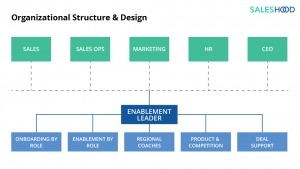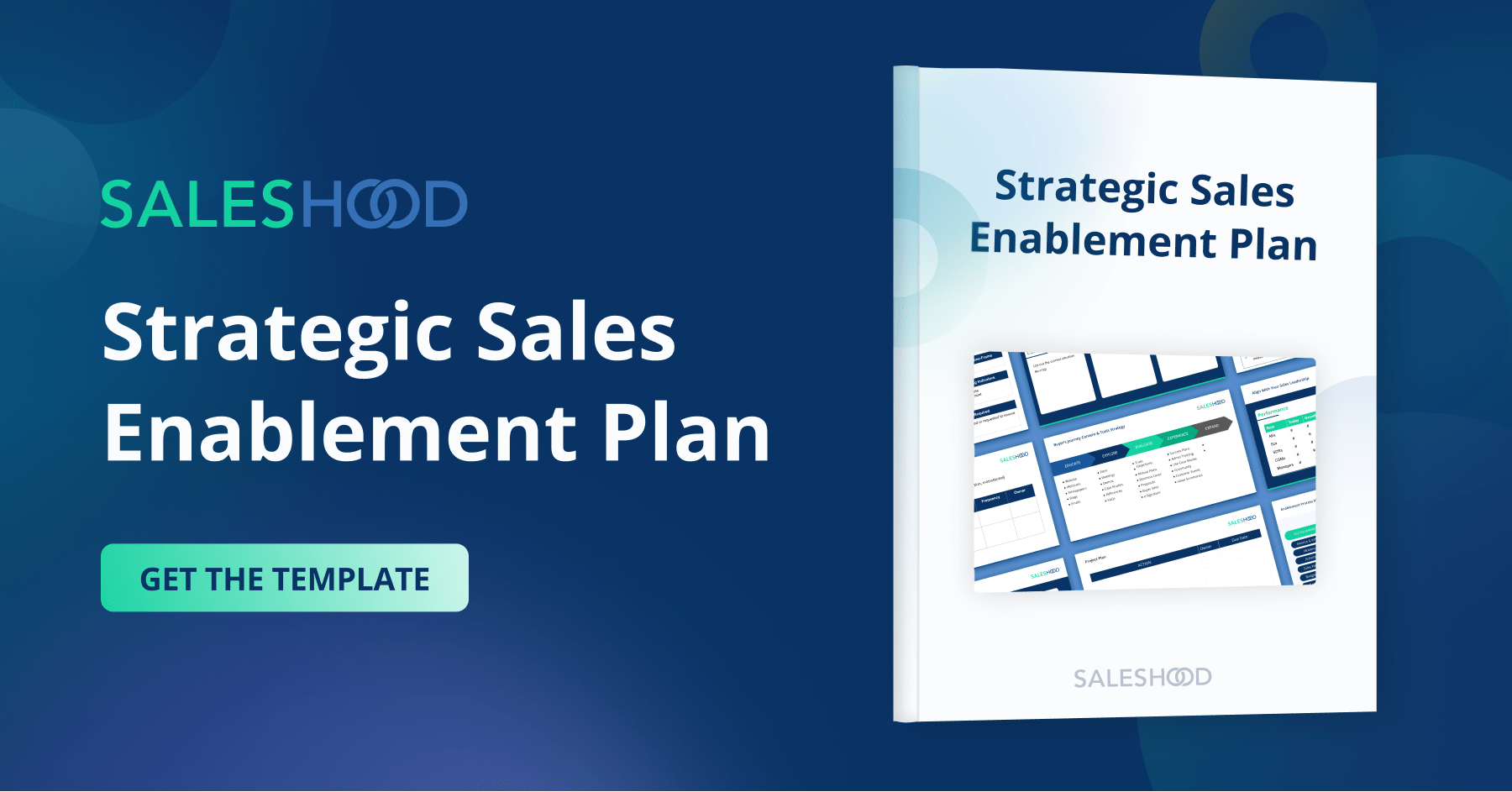Sales, marketing and revenue operations leaders reach out to us all the time asking these questions:
- Where should sales enablement live inside an organizational structure and why?
- What are the optimal sales enablement ratios?
- How should we structure our sales enablement teams?
- Do you have any template sales enablement job description?
The following blog will answer these questions for you and provide many templates and recommendations to structure your sales enablement teams to optimize reach and impact.
The factors that make it hard to answer these questions with certainty are the unknowns of the people, politics, and power base in the company. We need to look at the skills of our leaders and employees to understand where sales enablement can be most effective. We need to understand how decisions are made to ensure the organizational political realities will be an enabler of the sales enablement team’s success versus a hindrance. And we need to understand where the power base is in the company. All these factors will guide us to create a better sales enablement organizational structure. How we staff our sales enablement team and align our people with each other will be a big contributor to their success. The goal of this blog post is to explore the different organizational structure scenarios and determine a way to decide what’s best for you and your company.
Sales Enablement Ratios
The first question we’re going to tackle is how many sales enablement team members should I hire? The answer is dependent on your company, goals, industry, and competitive landscape. More complex products and more geo-distributed workforces will need a larger sales enablement team.
Here are some sales enablement-to-employee ratios to consider. For every hundred employees, you should have one sales enablement person. When products are more complex and new markets are being opened, you should over-invest in sales enablement and have ratios be as low as one for every fifty or even one for every twenty-five employees. The chart below offers some specific guidance.
| Enablement/Sales Team Ratios | Go-To-Market Dynamics |
| 1:25 |
New markets New Product 100% remote teams > 40% year over year growth |
| 1:50 |
Multi-products Regional teams Active hiring |
| 1:100 |
Mature product Slow growth Teams are not remote |
Thinking Through Sales Team Structure and Organizational Design
The next question we get asked is how to structure the sales enablement team and how it should be organized. Every company is different, and all sales organizations are different. Sales enablement structure and how the team compliments the organizational design depends on the product, goals, skills, politics, etc. No two sales enablement teams or organizations are alike–even if they are similar, critical components will vary.
Who owns sales enablement should be decided based on many factors, including:
- Company size
- Company growth goals
- Company politics
- Market dynamics
- Company values
- Product complexity
- Where power lives in the organization
- Content creation strengths and weaknesses
- Individual leadership personalities and style
Your organizational structure, sales process, and internal culture will all play a role in deciding who owns sales enablement. The most important thing to remember is that enablement can live anywhere and be owned by one or many teams. It all depends on the factors listed above.
Sales Enablement Team Structure
Let’s talk a bit about how the sales enablement team should be structured. As mentioned, this depends on the size of your organization. Let’s say you have a very large organization, with over one thousand employees across many departments. Your sales enablement team would have to branch out in order to have a powerful and meaningful impact.
In such large organizations, sales enablement needs a lot of supporting pillars that coordinate with each other and every other department.
Sales enablement teams will be involved in:
- Strategic account planning
- Deal support
- Requests for proposals
- Business case development
- Providing and developing sales content
- Training and onboarding
- Requests for proposals
All of these different support pillars would have a competent, credible, and motivated leader who reports to a central head of sales enablement. This can be a separate entity, or this role can be taken over by anyone close to one of your main teams. The sales enablement team structure would look something like this:
Sales Enablement Team Leader
- Onboarding team
- Ongoing enablement by role team
- Regional coaches team
- Product enablement team
- Competitive team
- Deal support team
Where Should Sales Enablement Teams Report?
The short answer to the question of who should the sales enablement team report to is: It depends. Sales enablement can live anywhere and be owned by anyone. Sales, marketing, HR, and it can even be an organization-wide initiative. It can report to a dedicated sales enablement officer, or the CEO, CMO, or CRO. It all depends on who your people are, what your goals are, and how you work.
The most important question you should ask yourself when securing a place for sales enablement is “what stage is my company at right now, and what do I need sales enablement to accomplish?”. Answering this question will align your sales enablement team to the correct reporting structure.
Enablement Reporting To Sales/Revenue Leaders
This might seem like an intuitive thing to do – after all, sales enablement teams enable sales, so the best place for it might be at the same table with the sellers. There are a lot of obvious benefits to this choice. When sales enablement is owned by the sales team, they become a mean, lean sales-focused machine.
This is the most common solution. They have direct contact with the sales team and focus on what really matters to them. Having sales enablement in the sales department helps to align the enablement team with the sales team structure leaders, and streamline applicable solutions to the sellers.
Alternatively, there are cons to this choice. You are in danger of excluding the rest of your organization and being pigeonholed in the same box as sales. The focus of sales enablement should be on the whole organization, and the most successful teams work across the lines. It’s harder to make other departments be involved with sales enablement – most of them think that “it’s not about them”.
There is a false sense that sales enablement is only done for sales, which is not true because some of the best success stories of sales enablement include other departments and holistic growth. Here is a quick breakdown of the pros and cons of aligning your sales enablement team with your sales and revenue leaders.
PROS
- Sales enablement efforts are aligned with sales leaders
- Leads by example
- Focuses on what matters
- Facilitates getting resources and funding
CONS
- Excludes non-sales roles
- May create the perception that enablement is only being done for sales
Enablement Reporting to Sales/Revenue Operations
In some organizational structures, sales enablement lives with sales and revenue operation teams–typically when it’s run by a strong leader who understands strategic sales enablement. As companies mature and grow, it makes sense to put sales enablement under sales operations to inform priorities with data. There are some significant benefits to having sales enablement map directly to sales operations. Getting close to metrics provides focus and priority direction to the sales enablement team. I believe ultimately sales enablement and revenue operations should be very closely aligned. When sales enablement reports to revenue operations, initiatives that are run and executed are more easily measured against performance.
There is, however, a con to this organizational structure: under the wrong leadership and leadership style, sales enablement could be relegated to a training function and lose its impact and sales productivity punch. A vice president of sales operations with a sales enablement person under their organizational structure will potentially misrepresent and not highlight the real value of sales enablement. Investments will be at risk. We also tend to see sales operational leaders focus on metrics too much. There is a human side to enablement that is a must, and sometimes the operational folks miss that part of the job. Here is a quick breakdown of the pros and cons of aligning your sales enablement team with your sales/operations leaders.
PROS
- Uses a data-driven approach to sales enablement
- Is close to the metrics
- Uses one communication and calendar for enablement and operational issues
CONS
- May be perceived as just training
- May create the perception that enablement only being done for sales
- Will not have a seat at the table
- Will not have cultural changing, transformational impact
Enablement Reporting To Marketing
When sales enablement reports to marketing, there are many things that can go right – but there are also some things to be wary of. Marketing is an exciting department, full of stories, deadlines, goals, and dreams. They seem to have a life of their own, and there is a lot of good work that can be done in sales enablement with a marketing leader at the helm.
Some things that can be a true success when marketing is in charge include:
- Content creation – for sales training as well as customer education
- Informative and engaging materials about a variety of products
Marketers are natural content creators – this can be used as a powerful tool for sales enablement. Sales enablement ties all the best aspects of sales and marketing together in order to supercharge your sales process. This type of enablement best works for an organization that has a very complex variety of products or services.
The more great content generated about these products and services, the more knowledge and sales training can be applied to not only the sales team, but the entire organization. Having just-in-time knowledge about the right product at the right time can translate to immediate progress for the sales team.
The only thing to watch out for is that while it’s awesome for sales training and content creation, a sales enablement group that reports to marketing is in danger of being streamlined to serve marketing itself more than sales.
A great marketing department sometimes becomes like Narcissus – they focus on themselves a bit too much. There’s a danger of the sales enablement becoming misaligned with sales and revenue and too focused on the needs of the marketing department. Here is a quick breakdown of the pros and cons of aligning your sales enablement team with marketing.
PROS
- Aligns with content teams
- Is role agnostic
- Elevates the perception of marketing
CONS
- Gets deep into content and forgets sales skills and coaching
- Results in less alignment with sales teams and revenue teams
Enablement Reporting To Human Resources (HR)
Human resources is a great place for sales enablement to live if you want to concentrate on education and assessment of all employees. HR is very good at getting to the roots in your organization – from the ground up. As a given, they have the necessary tools to change company culture and will use them to make sales enablement an important backbone. Sheevaun Thatcher, VP of Learning and Enablement became one of the first sales enablement leaders to successfully have their HR team take notice of what they were doing and apply their principles to the rest of the organization. They prioritized peer accelerated learning, manager coaching, modern learning principles as a growth lever, culture builder, and revenue driver across the entire company.
If you associate human resources with boring training videos and safety protocols, you should take a look at how human resource departments are rebranding themselves. They are game-changers, driving company philosophy, and enabling employees by nature. If you have a passionate HR department, they might be one of your best sales enablement secret weapons, getting sales and marketing, staff and management alike hyped up and ready to make meaningful changes across the whole organization.
Of course, sometimes the cons of switching responsibility for sales enablement to HR is that the whole process becomes more about training and getting everyone on board rather than enabling in real-time. Human resources have an interest in onboarding, training, and are great at scaling – but sometimes they can get too wrapped up in that and not focus on the competitive side of the sales teams. Sales and marketing teams tend to be dismissive of human resources as not hungry or aggressive enough. This might hurt the overall credibility of a sales enablement team that reports to HR. Here is a quick breakdown of the pros and cons of aligning your sales enablement team with HR.
PROS
- Emphasizes learning and assessments
- Helps scale by building templates and frameworks for all employee roles
- Creates culture
- Helps to reinvent human resources
- Makes CEO the top priority
CONS
- Creates a negative perception because of the bad rap human resources has
- Becomes simply a training team and loses impact of enablement
- Doesn’t have the credibility to effect real change
Tips To Staff Sales Enablement Teams
It’s amazing how many emails and texts I get from sales leaders or CEOs looking for sales enablement professional referrals and tips to staff sales enablement teams. The sales enablement profession is relatively new. It’s hard to find people with the skills and competencies to be successful sales enablement practitioners. Sometimes, the best sales enablement people are right in front of us.
While I love that sales enablement is becoming a must have role and technology, there is a lot of confusion on the skills and expertise. The reply I give to the emails and texts I get asking for referrals is, it depends. Every company is different. In my new book Enablement Master, I devote a whole chapter to profiling enablement professionals and mapping out competencies.
Let’s be open-minded and creative about finding people who could be great at doing sales enablement. Don’t just look for curriculum designers to create and deliver content. Look for people who know your people, processes and priorities to execute your plan. Credibility matters.
Here are four roles who could be great sales enablement practitioners.
Sales Managers
Experience in sales management and sales coaching is a strength and perfect for companies requiring hands-on coaching and geo-expansion. Partner them with your subject matter experts and have them build and own the plans.
Product Marketing
Companies looking to build content and coaching on products, competitors and customer stories will benefit by having product marketers become a sales enablement practitioner. Their knowledge of buyer personas and market dynamics along with their skills in presentations puts them in a good place to deliver coaching and content to their sales teams. Many product marketers also have credibility with sales too.
Sales Engineers / Solution Consultants
Experience working with products and coaching sales teams makes sales engineers great candidates for sales enablement. Experience working with sales and technical experience with a product and solution is a big plus. They are trusted by sales and they are already great listeners and coaches.
Top Salespeople
Companies needing more 1:1 coaching will benefit from moving top performers into enablement roles. They will be great coaches and onboarders. They will be great to sit down with new salespeople and struggling salespeople to review prospecting strategies, territory plans and deal strategies. They’ll be great if sales managers are spread too thin or if there are many first time sales managers.
You can see how there are many different scenarios and you can creatively find sales enablement professionals from your own company to fill these roles.
The very best people to enable our teams are the ones that lived “a day in the shoes” of the role. They will have the expertise and credibility to delivering training and coaching.
The common characteristic we see in successful sales enablement professional is the desire to help companies align their people, process and priorities to grow revenue faster. Successful sales enablement are able to connect with leaders to understand their go-to-market priorities and then translate those priorities into coaching and content to be delivered to their sales teams. This is bigger than just creating sales training and curriculum.
There are many people who could be great sales enablement practitioners. Let’s find them and enable them.
Sales Enablement Roles
A well-structured sales enablement team typically includes a mix of strategic, operational, and content-focused roles that align with the company’s sales goals. Here’s a breakdown of the common roles and responsibilities:
1. Head of Sales Enablement (VP/Director)
-
Owns the overall enablement strategy and alignment with business goals.
-
Works cross-functionally with Sales, Marketing, Product, and HR.
-
Defines metrics to track effectiveness and ROI.
-
Oversees tools, training, and content strategy.
2. Sales Enablement Manager
-
Designs and executes programs for onboarding, continuous learning, and sales plays.
-
Partners closely with frontline managers to support field readiness.
-
Coordinates content development, certifications, and performance tracking.
3. Content Enablement Lead / Instructional Designer
-
Creates and curates training content, playbooks, and learning paths.
-
Ensures content is aligned to the buyer journey and updated regularly.
-
May work within a system like SalesHood, Highspot, or Seismic.
4. Sales Readiness / Training Specialist
-
Delivers live and virtual training sessions.
-
Facilitates workshops, role plays, and certifications.
-
Works on rep skills development and knowledge reinforcement.
5. Sales Onboarding Specialist
-
Owns new hire programs, ensuring fast ramp-up.
-
Tracks onboarding KPIs like time to first deal, time to productivity.
-
Coordinates with HR and Sales Managers for consistent experience.
6. Enablement Operations / Program Manager
-
Manages enablement tech stack (e.g., SalesHood, LMS, CMS, analytics tools).
-
Builds dashboards and reports to track enablement impact.
-
Supports calendar planning, communication, and event logistics.
7. Field Enablement / Regional Enablement Partner
-
Acts as a liaison between global enablement and local teams.
-
Customizes programs for regional or segment-specific needs.
-
Gathers feedback to inform program adjustments.
Optional / Evolving Roles:
-
AI & Insights Specialist – Integrates AI tools for personalization and performance analysis.
-
Partner Enablement Manager – Focuses on enabling channel and partner sales teams.
-
Customer Success Enablement – Supports CSMs with training and resources.
Sales Enablement Job Descriptions
Director or VP of Revenue Enablement Leader
Director Level Summary:
You are a hands-on, strategic revenue enablement leader who thrives on solving sales productivity challenges and aligning cross-functional teams. You work closely with sales managers and reps to design programs that drive measurable impact. You’re a builder—of content, process, and systems—and you know how to implement programs that scale.
VP Level Summary:
You are a strategic executive with a proven track record of building and scaling world-class revenue enablement functions. You align closely with senior leadership, drive go-to-market strategy, and influence the entire revenue engine. You bring deep expertise in systems, operations, and AI-powered enablement to transform how teams sell, onboard, and grow.
Key Responsibilities
Both Roles:
-
Own the development and execution of an enablement strategy that aligns with top revenue priorities.
-
Create enablement calendars that drive focus on key themes, sales plays, product launches, and skill development.
-
Design and deliver role-based onboarding and continuous learning programs to ramp teams efficiently.
-
Build scalable training content, sales playbooks, and resources that reps and managers actually use.
-
Collaborate closely with Sales, Marketing, Product, Sales Ops, and Customer Success to align messaging, tools, and delivery.
Director Level:
-
Partner with frontline managers to deploy programs that improve rep productivity and pipeline conversion.
-
Manage and optimize key enablement systems (e.g., SalesHood, LMS, CMS, conversation intelligence, sales engagement platforms).
-
Leverage AI tools for content personalization, training delivery, and performance analysis.
-
Track program effectiveness using leading and lagging indicators; report results clearly to stakeholders.
VP Level:
-
Lead the enablement vision, strategy, and team across global revenue functions.
-
Drive executive-level alignment across CRO, CMO, CEO, and Product Leadership.
-
Champion the adoption of AI across sales enablement (e.g., predictive coaching, content recommendations, analytics).
-
Evaluate, implement, and optimize the full enablement tech stack—including SalesHood—to support scale and global execution.
-
Build business cases and influence strategic decisions through data-backed insights and financial modeling.
Skills & Experience
-
10+ years in revenue enablement, sales strategy, or sales operations (SaaS/software preferred).
-
Experience leading cross-functional enablement initiatives with measurable outcomes.
-
Proven ability to implement and manage enablement systems including SalesHood, Highspot, Seismic, Mindtickle, Showpad.
-
Experience using AI in enablement workflows (e.g., personalized learning, AI-driven coaching, content recommendations, guided selling).
-
Excellent project management and organizational skills.
-
Strong consultative skills with the ability to translate GTM strategy into enablement action.
-
Direct sales or sales management experience highly preferred.
-
Product marketing or content development experience is a plus.
-
Skilled in building executive presentations and business cases tied to revenue impact.
AI Efficiency = Leaner Enablement
AI is transforming the role—and size—of enablement teams. With SalesHood AI, companies have seen a 231% increase in coaching adoption, meaning reps are getting more value from training without additional human effort. But the more disruptive stat is the 45% reduction in enablement headcount—a number that directly translates to needing fewer enablement resources to achieve the same or greater outcomes.
Thanks to features like conversational AI search, real-time insights, and context-aware recommendations, enablement is now embedded, on-demand, and automated. This shift enables companies to reduce enablement headcount while still accelerating ramp time, increasing rep productivity, and improving win rates. The org design of enablement is evolving—from centralized, people-heavy teams to lean, AI-augmented functions that scale across the business.
AI is reshaping enablement by doing more with less—fewer people, bigger impact, smarter scaling, and the end of traditional teams.
Summary
The biggest takeaway we hope you’re walking with after reading this blog is that there is no right answer to this question because every organization is different. The right organization team structure will vary by company. Consider your goals, people, and executive personalities when evaluating where the sales enablement team should live organizationally and how to structure the team.
Sales enablement can live with sales or marketing. Put it in sales in the early days when productivity and metrics aren’t being met. Move it to sales/revenue operations as the program and team mature. It can live in marketing if a company is focused on product enablement and releasing many products all the time. Keeping marketing accountable for sales enablement is a natural extension of the product marketing role. It’s also okay to move it to human resources after a center of sales excellence is officiated and there is consensus around the organization that sales teams are leading the way to drive improved employee productivity.
Regardless, never forget that sales enablement is a team activity. Done right, enablement brings teams together in a collaborative fashion to solve problems and improve employee productivity.




